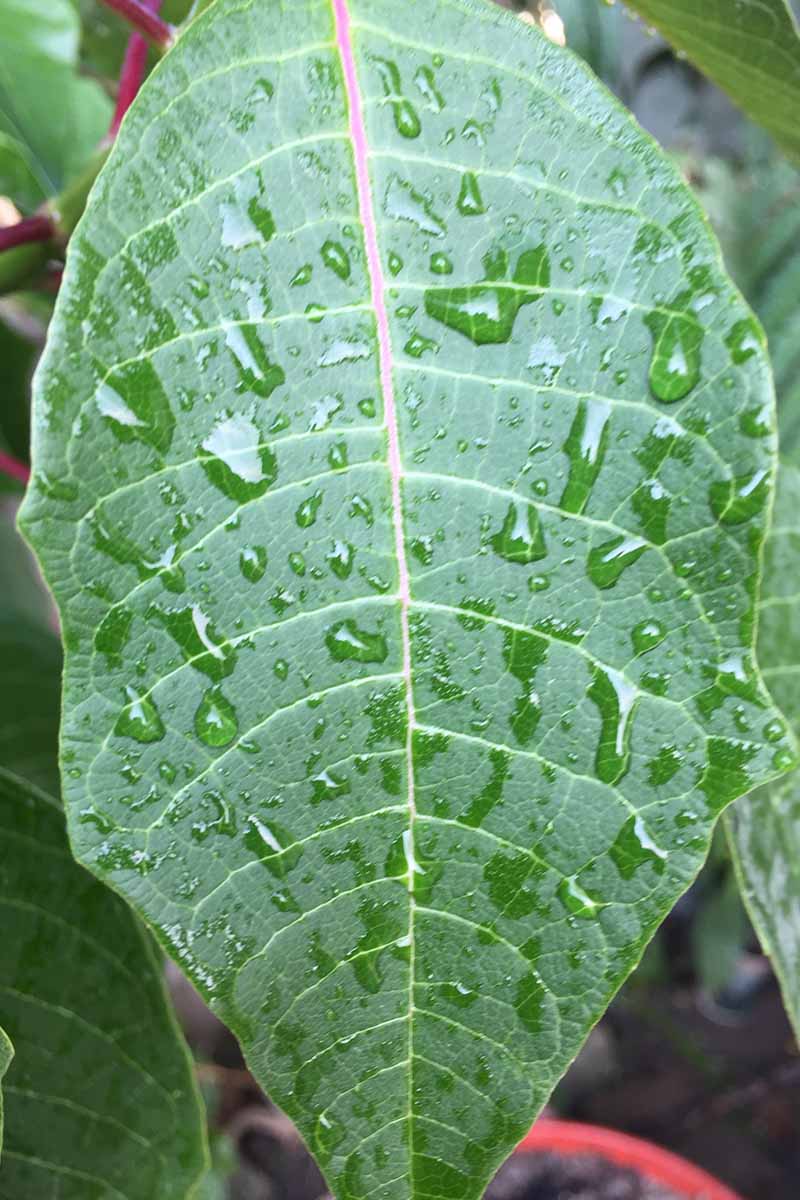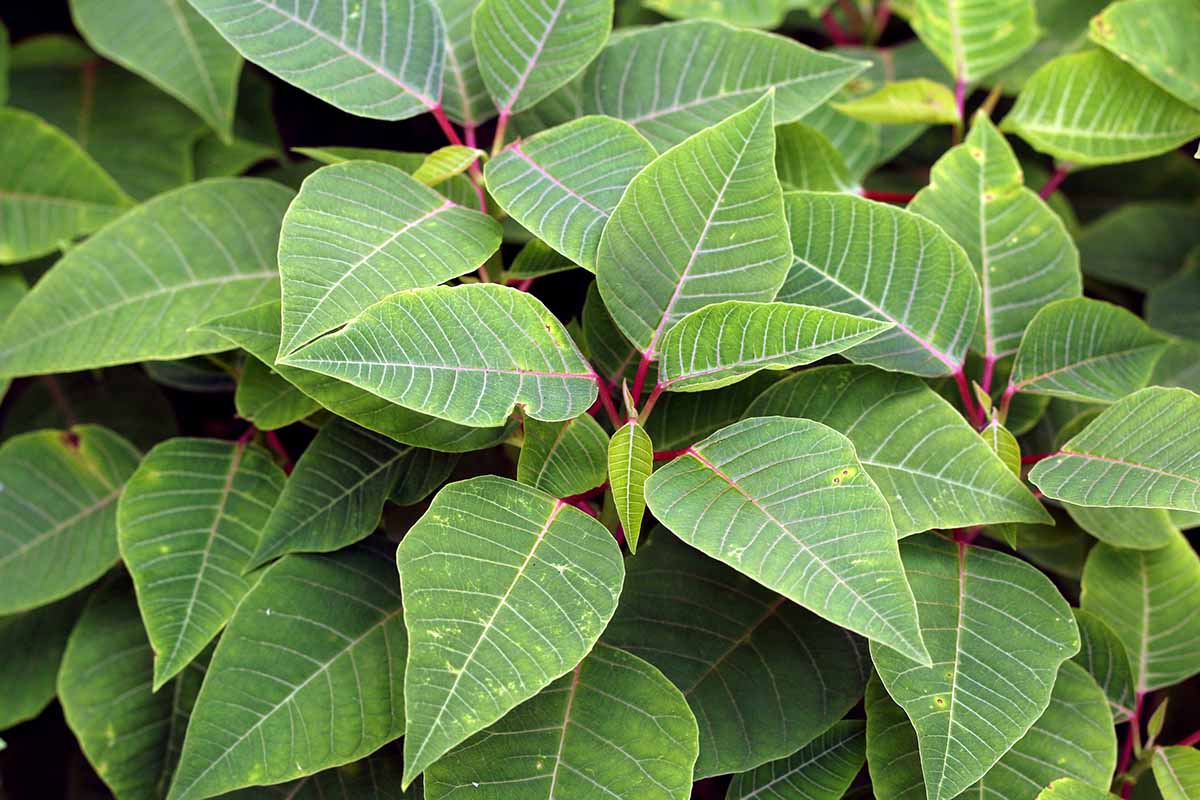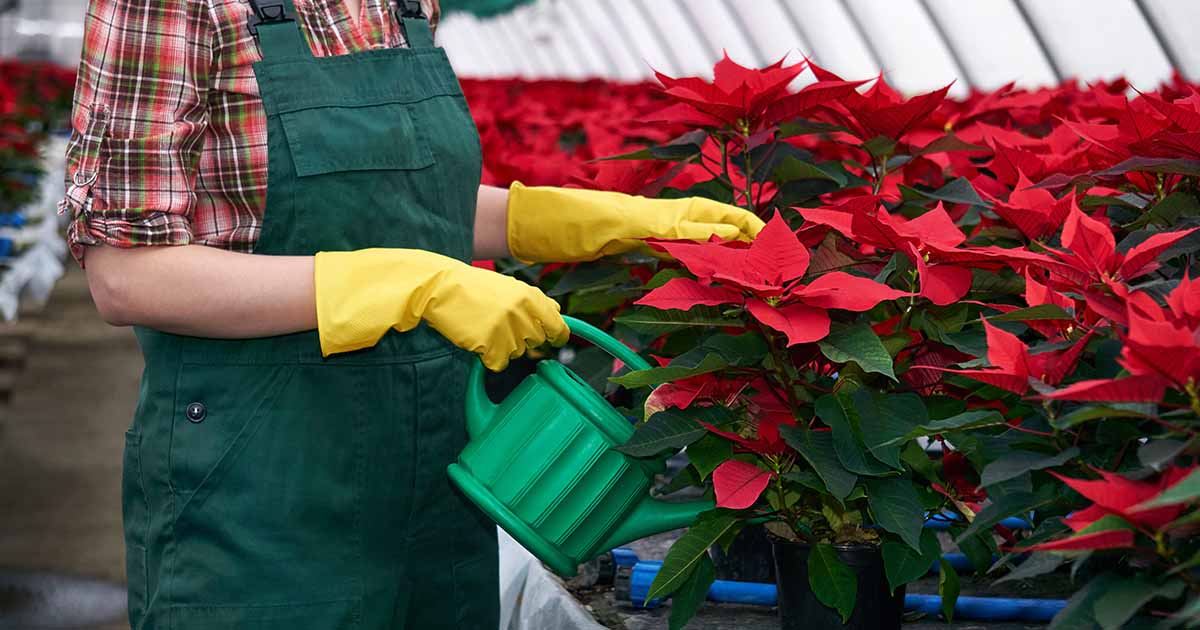Water is essential. Without good ol’ Adam’s ale, the glorious poinsettia would look like nothing more than a rather sorry-looking clump of foliage, eventually succumbing to an untimely death.

We link to vendors to help you find relevant products. If you buy from one of our links, we may earn a commission.
Humans would of course suffer a similar fate due to lack of moisture.
I know I would spend far too much time trying and failing to swallow pills, for example, all the while looking as if I were in dire need of the Heimlich maneuver.
And without an adequate supply of H2O, countless amusement parks would just be places where half-naked folks like to hang out in pool-shaped holes, trying to slide down insufficiently slippery surfaces.
When it’s properly hydrated, Euphorbia pulcherrima will grow into a dark green-leafed beauty that blooms with gorgeous red, pink, yellow, or cream-colored bracts.
But deprive a poinsettia of the water that it needs, and it’ll become stunted, wilted, and chlorotic. Not at all ideal for producing those holiday hues we’ve all grown to love.
Luckily, watering these plants doesn’t involve some mystical set of techniques that require a multi-year, “Batman Begins”-style pilgrimage to learn.
It’s actually pretty simple – especially when compared to the martial arts skills that Christian Bale’s Bruce Wayne learned from the members of the League of Shadows.
Interested in proper poinsettia watering? Then your training begins now.
Although, to quote Liam Neeson’s Ra’s Al Ghul: “The training is nothing… the will is everything.”
Let’s clear up one thing before we begin: it’s always best to avoid overhead watering.
Splashing lots of water onto the foliage from above wastes H2O, fails to irrigate the roots properly, and creates an optimal environment for pathogens to thrive. Be sure to apply irrigation directly to the root zone instead, whenever possible.

If you happen to live in a Zone where you can grow your poinsettias outside year-round, or if you bring them outdoors in the summer for a little vacation, it’s generally alright if they get rained on from time to time.
But proper airflow, sun exposure, and well-draining pots are key so that excess moisture has a chance to dry.
Here, we’ll focus chiefly on those grown indoors as houseplants. Let’s begin!
How to Water Poinsettias During Dormancy
Most instructions on growing poinsettias usually kick off with the plant in a state of vibrant lushness, not when they’re dormant.
But since many folks acquire these plants around Christmastime for decking their halls with Yuletide color, it makes sense to start at their dormancy, since that’s what occurs in the months after an E. pulcherrima is in full bloom.

During this time, the plant’s watering needs are greatly reduced.
This is primarily because the plant isn’t actively growing new leaves, but also because it isn’t exposed to as much heat and light as it was in the comfort of a nursery prior to purchase, or in prior seasons of the year – both of which increase evapotranspiration rates, or how much H2O is taken up and subsequently released in order for the plant to grow and function.
A solid starting point is one bout of deep watering every two weeks after the colorful bracts fade and leaves begin to drop. For container-bound plants, “deep watering” means irrigating until excess water starts to leak out the bottom of the container.

If the leaves start shriveling or wilting, then you may need to up your irrigation frequency.
Keeping a written record of how often you irrigate your poinsettias provides valuable data for future reference, so break out that gardening journal!
And feel free to use a moisture meter with a probe you can sink into the soil if that helps you to judge when the time is right.
How to Water During the Growing Season
The growing season technically starts as soon as the plant starts putting out new tissues. When this happens, you should consider your poinsettias to be done with dormancy.

When new growth appears, more water is needed.
An E. pulcherrima that’s actively growing new leaves needs to be sitting in a medium that’s constantly moist. Therefore, you’ll want to deeply irrigate whenever the surface of the media feels dry to the touch.
If you’re ever in doubt, you could try laying a single-ply piece of tissue on top of the soil to clear things up for yourself.
If wet stains start to appear on the tissue, that indicates moisture. If it remains dry, then you’ve got the green light to go ahead and irrigate!

Be sure to water thoroughly so excess runs out of the drainage hole in the pot.
Do this over the sink, giving the pot at least 10 to 20 minutes to drain, and be sure to empty any saucers or cachepots without drainage holes before returning your plant to its usual location.
Soil Drainage Tips
These guys do love their moisture… but they also need to be sitting in well-draining soil to avoid developing root rot and other diseases brought on by water-loving pathogens.
For container plantings, your standard 50/50 mix of peat moss and perlite will work just fine.

But even the fastest-draining medium will remain waterlogged if it’s filling a container with no drainage holes. Ensure that your pots have at least one, if you haven’t already done so.
Many store-bought poinsettias come with their containers wrapped in a decorative foil. This can prevent adequate drainage, as do decorate cachepots without holes.
Removing any foil covers soon after you bring plants home is recommended. If you wish to keep them in place because you like their festive look, be sure to remove them when watering.

You could also punch some holes where the foil covers the container’s existing drainage holes, and place a saucer beneath the pot to catch any drips.
Water You Waiting For?
Once Bruce Wayne finished his training, he rushed to purge Gotham City of the crime that took his parents’ lives. What’s stopping you from watering a poinsettia with that same sense of urgency?

All pop culture comparisons aside, now you can water an E. pulcherrima like a pro! Have fun growing these stunning beauties for the holiday season and beyond!
Any comments pertaining to poinsettia watering or Christopher Nolan’s “Dark Knight” trilogy can go into the comments section below.
Have these specimens piqued your interest? Then have a look-see at some more poinsettia guides next:











